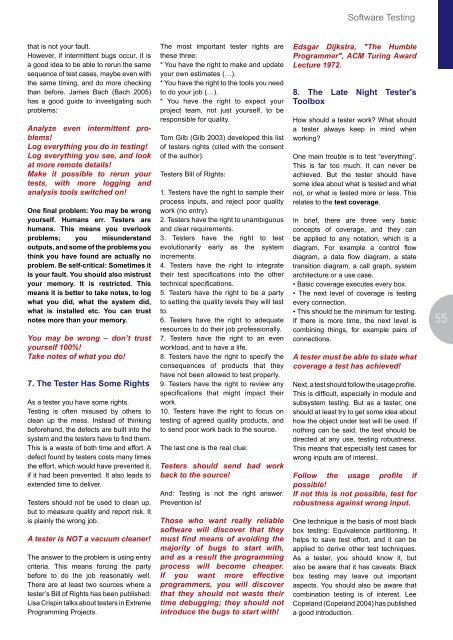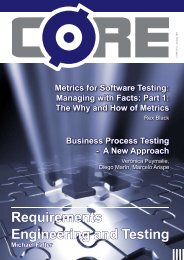Comparison of Change Management Systems
Comparison of Change Management Systems
Comparison of Change Management Systems
Create successful ePaper yourself
Turn your PDF publications into a flip-book with our unique Google optimized e-Paper software.
that is not your fault.<br />
However, if intermittent bugs occur, it is<br />
a good idea to be able to rerun the same<br />
sequence <strong>of</strong> test cases, maybe even with<br />
the same timing, and do more checking<br />
than before. James Bach (Bach 2005)<br />
has a good guide to investigating such<br />
problems:<br />
Analyze even intermittent problems!<br />
Log everything you do in testing!<br />
Log everything you see, and look<br />
at more remote details!<br />
Make it possible to rerun your<br />
tests, with more logging and<br />
analysis tools switched on!<br />
One final problem: You may be wrong<br />
yourself. Humans err. Testers are<br />
humans. This means you overlook<br />
problems; you misunderstand<br />
outputs, and some <strong>of</strong> the problems you<br />
think you have found are actually no<br />
problem. Be self-critical: Sometimes it<br />
is your fault. You should also mistrust<br />
your memory. It is restricted. This<br />
means it is better to take notes, to log<br />
what you did, what the system did,<br />
what is installed etc. You can trust<br />
notes more than your memory.<br />
You may be wrong – don’t trust<br />
yourself 100%!<br />
Take notes <strong>of</strong> what you do!<br />
7. The Tester Has Some Rights<br />
As a tester you have some rights.<br />
Testing is <strong>of</strong>ten misused by others to<br />
clean up the mess. Instead <strong>of</strong> thinking<br />
beforehand, the defects are built into the<br />
system and the testers have to find them.<br />
This is a waste <strong>of</strong> both time and effort. A<br />
defect found by testers costs many times<br />
the effort, which would have prevented it,<br />
if it had been prevented. It also leads to<br />
extended time to deliver.<br />
Testers should not be used to clean up,<br />
but to measure quality and report risk. It<br />
is plainly the wrong job.<br />
A tester is NOT a vacuum cleaner!<br />
The answer to the problem is using entry<br />
criteria. This means forcing the party<br />
before to do the job reasonably well.<br />
There are at least two sources where a<br />
tester’s Bill <strong>of</strong> Rights has been published:<br />
Lisa Crispin talks about testers in Extreme<br />
Programming Projects.<br />
The most important tester rights are<br />
these three:<br />
* You have the right to make and update<br />
your own estimates (…).<br />
* You have the right to the tools you need<br />
to do your job (…).<br />
* You have the right to expect your<br />
project team, not just yourself, to be<br />
responsible for quality.<br />
Tom Gilb (Gilb 2003) developed this list<br />
<strong>of</strong> testers rights (cited with the consent<br />
<strong>of</strong> the author):<br />
Testers Bill <strong>of</strong> Rights:<br />
1. Testers have the right to sample their<br />
process inputs, and reject poor quality<br />
work (no entry).<br />
2. Testers have the right to unambiguous<br />
and clear requirements.<br />
3. Testers have the right to test<br />
evolutionarily early as the system<br />
increments.<br />
4. Testers have the right to integrate<br />
their test specifications into the other<br />
technical specifications.<br />
5. Testers have the right to be a party<br />
to setting the quality levels they will test<br />
to.<br />
6. Testers have the right to adequate<br />
resources to do their job pr<strong>of</strong>essionally.<br />
7. Testers have the right to an even<br />
workload, and to have a life.<br />
8. Testers have the right to specify the<br />
consequences <strong>of</strong> products that they<br />
have not been allowed to test properly.<br />
9. Testers have the right to review any<br />
specifications that might impact their<br />
work.<br />
10. Testers have the right to focus on<br />
testing <strong>of</strong> agreed quality products, and<br />
to send poor work back to the source.<br />
The last one is the real clue:<br />
Testers should send bad work<br />
back to the source!<br />
And: Testing is not the right answer.<br />
Prevention is!<br />
Those who want really reliable<br />
s<strong>of</strong>tware will discover that they<br />
must find means <strong>of</strong> avoiding the<br />
majority <strong>of</strong> bugs to start with,<br />
and as a result the programming<br />
process will become cheaper.<br />
If you want more effective<br />
programmers, you will discover<br />
that they should not waste their<br />
time debugging; they should not<br />
introduce the bugs to start with!<br />
S<strong>of</strong>tware Testing<br />
Edsgar Dijkstra, "The Humble<br />
Programmer", ACM Turing Award<br />
Lecture 1972.<br />
8. The Late Night Tester's<br />
Toolbox<br />
How should a tester work? What should<br />
a tester always keep in mind when<br />
working?<br />
One main trouble is to test “everything”.<br />
This is far too much. It can never be<br />
achieved. But the tester should have<br />
some idea about what is tested and what<br />
not, or what is tested more or less. This<br />
relates to the test coverage.<br />
In brief, there are three very basic<br />
concepts <strong>of</strong> coverage, and they can<br />
be applied to any notation, which is a<br />
diagram. For example a control flow<br />
diagram, a data flow diagram, a state<br />
transition diagram, a call graph, system<br />
architecture or a use case.<br />
• Basic coverage executes every box.<br />
• The next level <strong>of</strong> coverage is testing<br />
every connection.<br />
• This should be the minimum for testing.<br />
If there is more time, the next level is<br />
combining things, for example pairs <strong>of</strong><br />
connections.<br />
A tester must be able to state what<br />
coverage a test has achieved!<br />
Next, a test should follow the usage pr<strong>of</strong>ile.<br />
This is difficult, especially in module and<br />
subsystem testing. But as a tester, one<br />
should at least try to get some idea about<br />
how the object under test will be used. If<br />
nothing can be said, the test should be<br />
directed at any use, testing robustness.<br />
This means that especially test cases for<br />
wrong inputs are <strong>of</strong> interest.<br />
Follow the usage pr<strong>of</strong>ile if<br />
possible!<br />
If not this is not possible, test for<br />
robustness against wrong input.<br />
One technique is the basis <strong>of</strong> most black<br />
box testing: Equivalence partitioning. It<br />
helps to save test effort, and it can be<br />
applied to derive other test techniques.<br />
As a tester, you should know it, but<br />
also be aware that it has caveats: Black<br />
box testing may leave out important<br />
aspects. You should also be aware that<br />
combination testing is <strong>of</strong> interest. Lee<br />
Copeland (Copeland 2004) has published<br />
a good introduction.<br />
55



